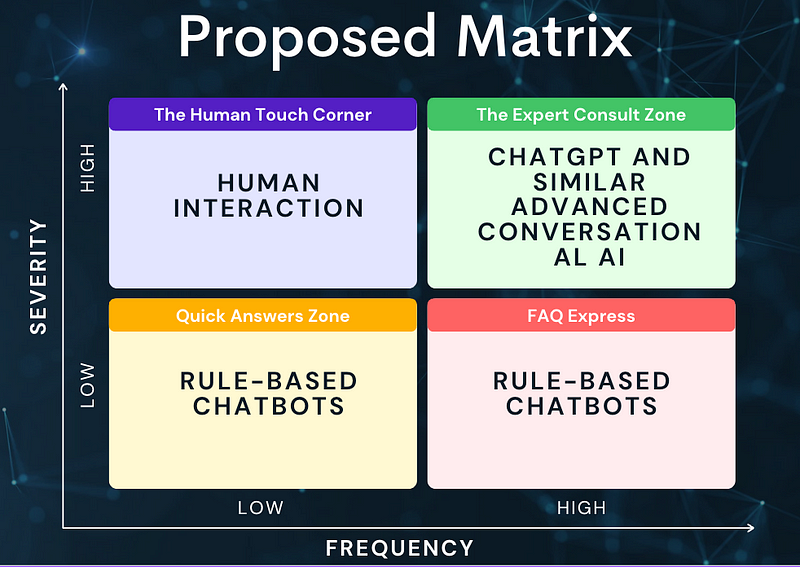Harnessing Chatbots and ChatGPT: A Synergy Model for Success
Written on
Introduction
The advantages of adopting technology, particularly automation, are well-documented and supported by various analyses. These benefits include increased cost-effectiveness in both time and human resources, enhanced data analysis capabilities, consistent quality, and global scalability. However, a crucial discussion is needed regarding why certain sectors, such as real estate and finance, are often hesitant to fully embrace these technologies. These reservations are valid and deserve exploration.
Consider the real estate sector. It involves decisions that can significantly impact people's lives, which necessitates customer service that can address both simple queries, like rental prices, and more complex issues, such as legal documentation. Industries with substantial financial stakes and emotional investments, like real estate and stock trading, face unique challenges. An error from a chatbot recommending a book is a minor issue, but a mistake in suggesting a property can take years to rectify. The distinct nature of products in real estate means that no two offerings are identical. Furthermore, the high emotional investment in such transactions highlights the need for agents with a strong emotional intelligence. Therefore, in these sectors, the role of human agents remains crucial.
The importance of recognizing these reservations and the human factor is vital for developing a comprehensive understanding of the four quadrants that facilitate the integration of chatbots and ChatGPT across various industries.
The Four Quadrants Synergy Model
The four quadrants synergy model considers both the complexity of customer interactions and the frequency with which companies encounter specific inquiries. This framework provides a strategy for effectively deploying both rule-based chatbots and advanced conversational agents like ChatGPT. While measuring frequency is straightforward, determining the severity of an interaction can be influenced by several factors, including financial stakes, regulatory issues, or potential reputational harm.
In the real estate field, a high-severity, low-frequency scenario could involve a complex legal conflict regarding property boundaries. While infrequent, this situation can have serious implications, potentially involving substantial financial stakes and legal consequences. In such cases, it is best handled by a knowledgeable human expert familiar with both the law and the specific details of the situation.
For the finance sector, a high-severity, low-frequency event may be an institution undergoing a regulatory audit. Although rare, this situation carries significant implications for the organization, including possible financial penalties and reputational damage. Navigating such scenarios requires the expertise of a human professional who understands compliance and regulatory matters.
Conversely, a high-severity, high-frequency situation might involve inquiries about mortgage rates or loan qualifications. These common questions carry significant stakes, as they affect critical life decisions. In this context, ChatGPT can provide sophisticated, data-driven responses but should be set up for handoff to a human expert if the complexity or risk level escalates.
Similarly, in finance, clients frequently seek advice on high-risk investments, which are both common and carry considerable financial implications. An advanced system like ChatGPT can analyze data to give initial guidance, but due to the high stakes involved, transitioning to a human financial advisor for personalized consultation is recommended.
The following matrix illustrates a framework for harmonizing customer experience (CX) channels:

This structure supports a tiered approach to customer interactions, ensuring optimal resource allocation while minimizing risk.
- Low Severity, Low Frequency: Basic inquiries like “What are your hours?” can be managed by a rule-based chatbot.
- Low Severity, High Frequency: Routine questions and appointment scheduling can also be efficiently handled by a rule-based bot.
- High Frequency, High Severity: More intricate yet common questions, such as mortgage details, can benefit from ChatGPT's nuanced answers.
- Low Frequency, High Severity: Unique and complex issues, like legal disputes, necessitate human intervention.
It's crucial to recognize that within high-severity categories, certain issues may carry more weight than others. For example, in real estate, a legal dispute involving zoning regulations with a government agency is generally more serious than a dispute between private parties due to its broader legal ramifications and public interest.
Similarly, in finance, a regulatory inquiry is typically seen as more severe than a high-value client seeking personalized investment guidance, given its wider implications for the organization.
As businesses grow, the initial frequency of high-severity inquiries may be low. However, as operations scale, patterns emerge, allowing the model to learn and adapt. This enhancement enables GPT models to grasp context better and offer more sophisticated responses.
Key Takeaways
While this paradigm provides a framework for harmonizing CX channels in contemporary organizations, it represents just one perspective and can be tailored to fit a company's digital maturity and risk tolerance. For instance, a technology-driven fintech company requiring rapid responses may lean more heavily on ChatGPT, which can appear in multiple quadrants. Cost considerations for implementation will also play a significant role in companies' strategic decisions, including traditional firms. Nevertheless, this proposed model may find practical applications in various organizations.
What are your thoughts on this model?